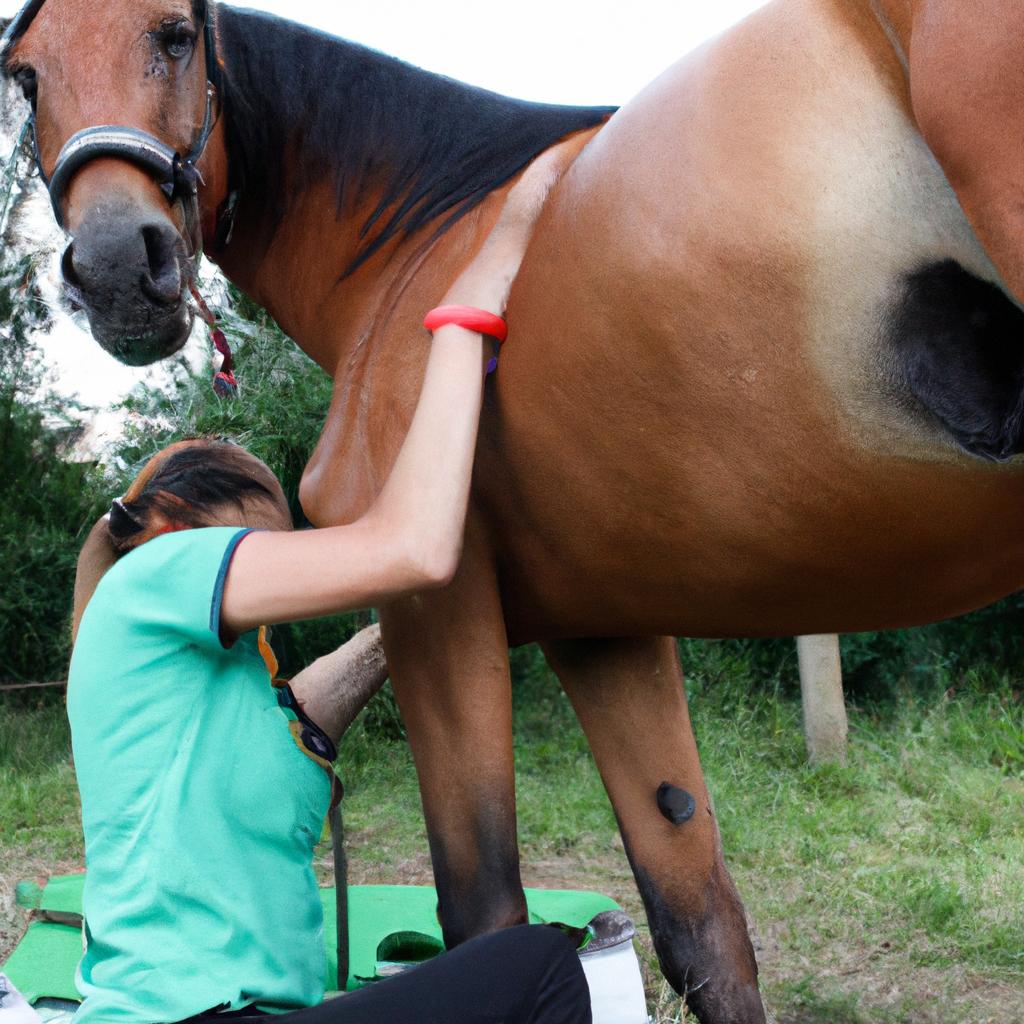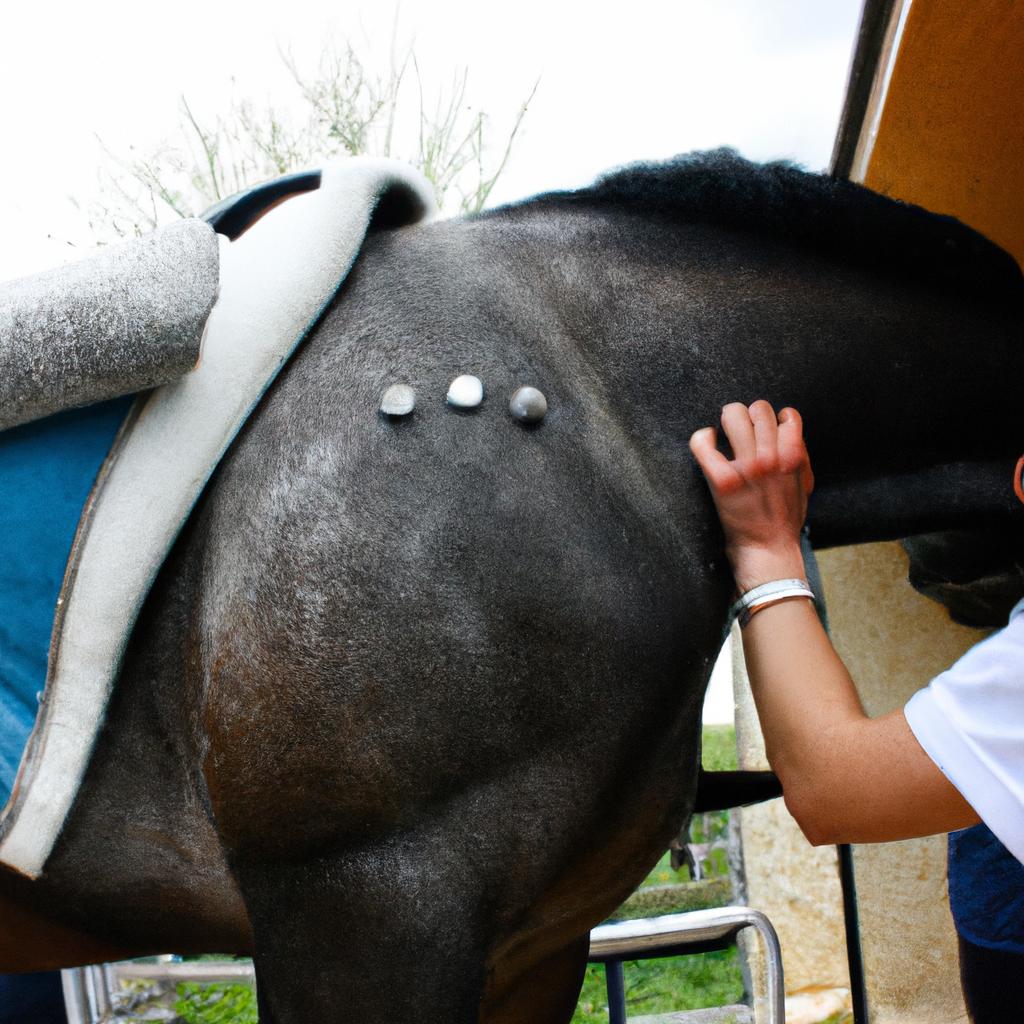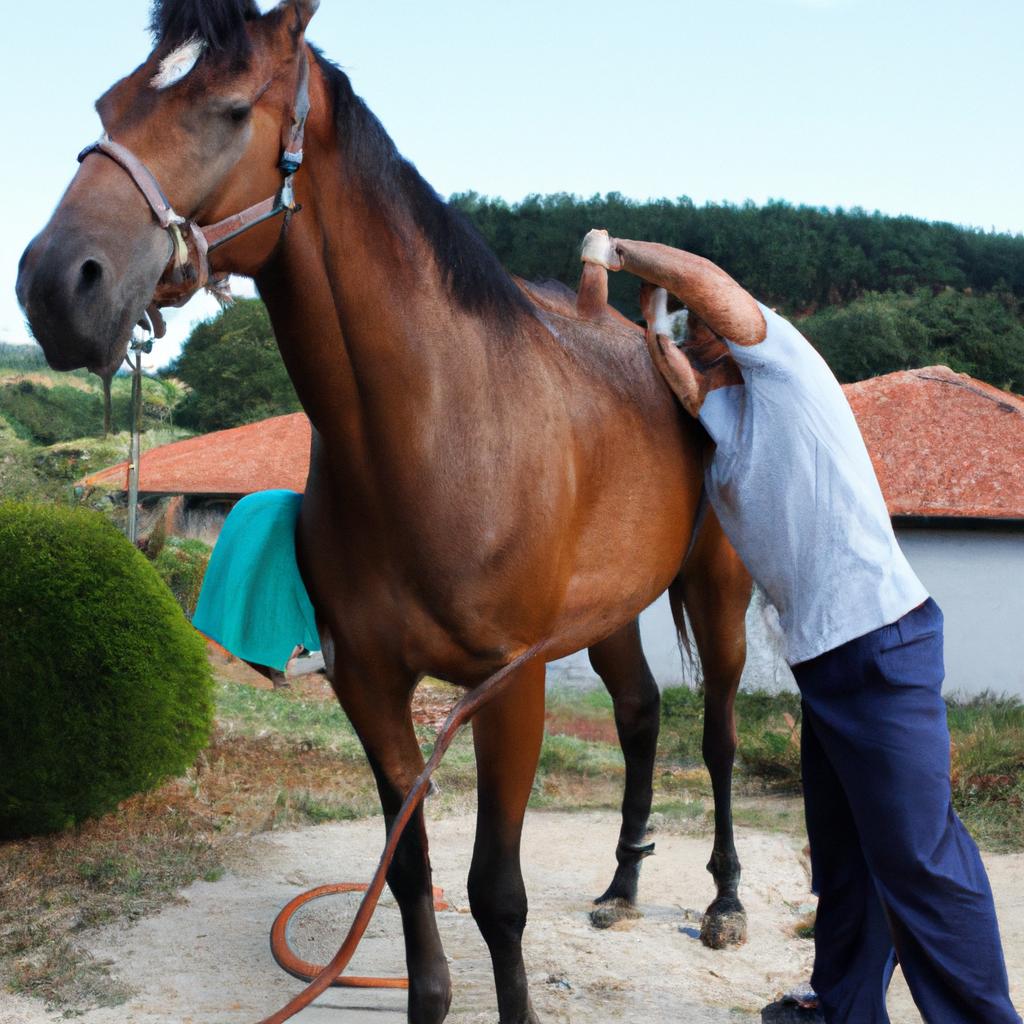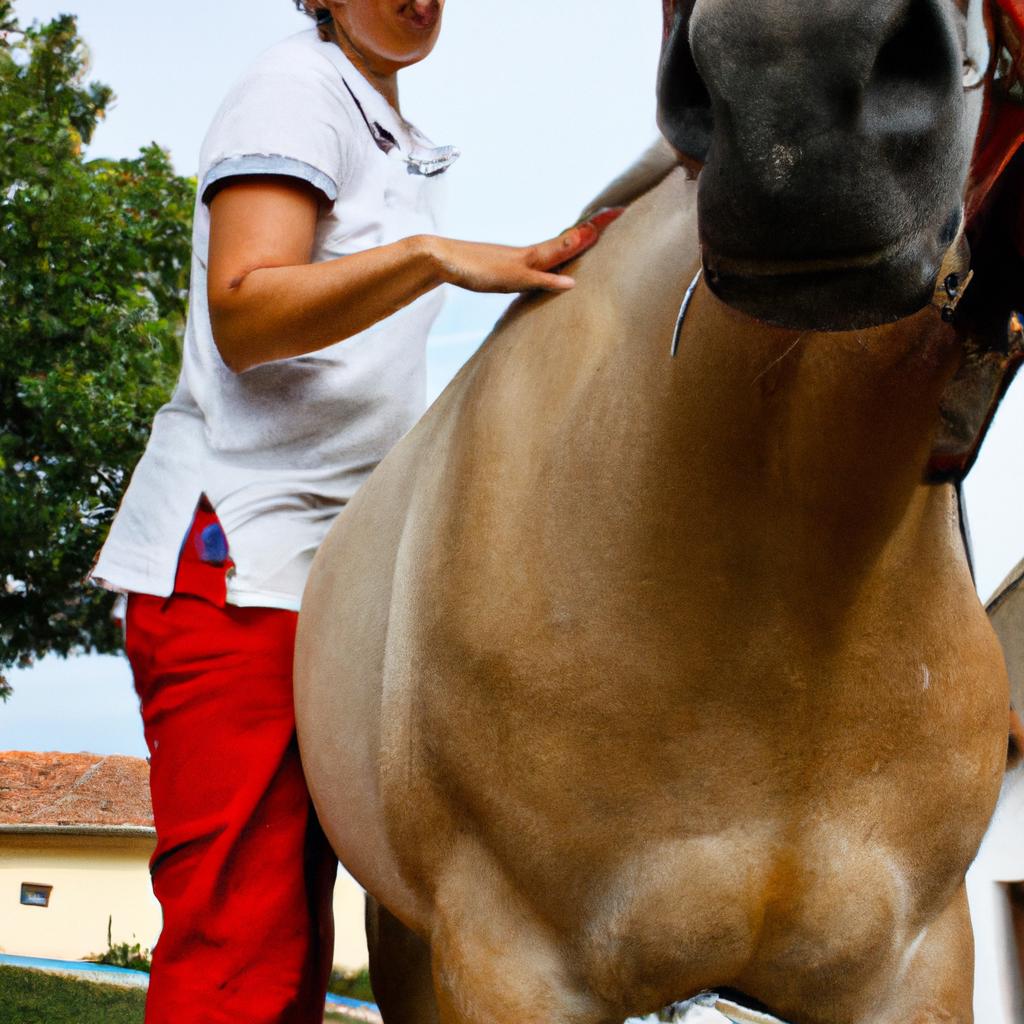Horse Anatomy and Physiology: Safety and Effectiveness of Chiropractic for Horses
In the world of equine sports, ensuring the health and well-being of horses is paramount. One approach that has gained significant attention in recent years is chiropractic care for horses. This article aims to explore the safety and effectiveness of chiropractic interventions on horse anatomy and physiology, shedding light on its potential benefits.
Consider a hypothetical scenario where a competitive show jumper experiences a decline in performance despite rigorous training regimes. The rider notices subtle changes in the horse’s gait, indicating possible musculoskeletal issues. In such cases, traditional veterinary treatments may not fully address these concerns. This prompts an investigation into alternative therapies like chiropractic care, which focuses on diagnosing and treating biomechanical dysfunctions within the spine and extremities. Understanding how chiropractic techniques interact with horse anatomy and physiology can provide valuable insights into their impact on equine performance and overall welfare.
As we delve into this topic further, it becomes imperative to critically evaluate existing scientific literature surrounding chiropractic interventions for horses while considering any potential risks or limitations associated with this practice. By examining empirical evidence from relevant studies, we aim to ascertain whether chiropractic care holds promise as a complementary therapy for enhancing horse movement and overall well-being.
Several studies have investigated the effects of chiropractic interventions on horse anatomy and physiology. One study, published in the Journal of Equine Veterinary Science, examined the impact of chiropractic adjustments on spinal range of motion in horses. The researchers found that chiropractic treatments resulted in significant improvements in spinal flexibility, suggesting that these interventions may help alleviate musculoskeletal restrictions and enhance overall movement quality.
Another study, published in the Journal of Animal Physiology and Animal Nutrition, explored the effects of chiropractic care on gait parameters in horses with back pain. The findings revealed that chiropractic treatments led to improvements in stride length, step duration, and symmetry, indicating enhanced locomotor function and reduced discomfort.
While these studies suggest positive outcomes associated with chiropractic care for horses, it is important to acknowledge potential risks and limitations. Chiropractic adjustments must be performed by qualified professionals who have undergone specialized training in animal chiropractic techniques. Inappropriate or poorly executed manipulations can potentially cause harm or exacerbate existing conditions.
It is also essential to consider individual variations among horses when assessing the effectiveness of chiropractic interventions. Each horse may respond differently to treatment based on factors such as their conformation, previous injuries or trauma, and overall health status. Therefore, a thorough evaluation by a knowledgeable veterinarian or equine chiropractor is crucial before initiating any chiropractic interventions.
Furthermore, while many anecdotal reports endorse the benefits of equine chiropractic care, further scientific research is needed to establish its efficacy beyond doubt. Rigorous randomized controlled trials involving large sample sizes are necessary to provide more robust evidence regarding the safety and effectiveness of these interventions.
In conclusion, exploring the safety and effectiveness of chiropractic care for horses involves considering its impact on horse anatomy and physiology. Existing literature suggests potential benefits such as improved spinal range of motion and enhanced gait parameters. However, caution should be exercised when choosing a qualified professional to perform these treatments and considering individual variations among horses. Further scientific research is needed to strengthen the evidence base and fully understand the potential of chiropractic interventions in promoting equine health and performance.
An Overview of Horse Anatomy
Imagine a scenario where a horse is experiencing discomfort and restricted movement due to an injury. The owner seeks the help of a veterinarian, who performs a thorough examination and identifies potential issues in the musculoskeletal system. Understanding the anatomical structure of horses is crucial for comprehending the underlying causes of such problems and exploring effective treatment options. This section provides an overview of horse anatomy, highlighting key features that contribute to their unique physiology.
To begin with, it is important to recognize that horses have evolved as highly specialized animals, enabling them to perform various tasks efficiently. Their skeletal structure consists of more than 200 bones, which provide support and protection for vital organs while also facilitating locomotion. Notably, the equine spine encompasses seven cervical vertebrae, eighteen thoracic vertebrae connected to ribs, six lumbar vertebrae supporting powerful hindquarters, five sacral vertebrae fused into the pelvis, and around twenty coccygeal (tail) vertebrae. This complex arrangement allows for flexibility along specific regions and helps absorb forces experienced during motion.
Moreover, understanding the muscular system plays a pivotal role in comprehending how horses move and function biomechanically. Horses possess well-developed muscles that are responsible for generating power and propelling them forward. These muscles can be categorized into three main groups: axial muscles located near or on the spine; appendicular muscles associated with limbs; and visceral muscles found within internal structures like blood vessels or digestive organs. Each muscle group serves different purposes in maintaining posture, providing stability during locomotion, or assisting specific movements required by riders or athletes.
Appreciating the complexity of horse anatomy extends beyond just bones and muscles; it involves considering other physiological systems as well. For instance, horses possess a remarkable circulatory system consisting of a four-chambered heart that efficiently pumps oxygenated blood throughout their bodies. Additionally, they have a unique digestive system adapted for grazing, with a large cecum and hindgut fermentation to facilitate nutrient absorption from fibrous plant materials. Understanding these physiological systems enables veterinarians and equine professionals to assess overall health and diagnose potential issues that may affect performance or well-being.
In the subsequent section about “Understanding the Musculoskeletal System of Horses,” we will delve deeper into the intricate relationship between horse anatomy and its musculoskeletal function. By examining how various components interact within this complex framework, we can gain further insight into diagnosing and treating ailments affecting horses’ mobility and overall athletic capabilities.
Understanding the Musculoskeletal System of Horses
The intricate structure and functioning of the musculoskeletal system in horses play a vital role in their overall health and performance. Understanding how each component interacts is crucial for identifying potential issues and implementing effective treatment strategies. In this section, we will delve deeper into the musculoskeletal system of horses, highlighting its complexity through an example.
Imagine a scenario where a dressage horse named Bella starts showing signs of stiffness and resistance during training sessions. Her owner notices that she struggles to engage her hindquarters properly, resulting in difficulty executing movements requiring strong impulsion. Recognizing that these problems might be related to her musculoskeletal system, Bella’s owner seeks further understanding of the underlying causes.
To comprehend the intricacies involved in such cases, it is important to consider key aspects of horse anatomy:
- Skeletal Structure: The skeleton provides support and protection while serving as an attachment point for muscles, tendons, and ligaments.
- Joints: These flexible connections between bones enable movement while also providing stability.
- Muscles: Responsible for generating force and facilitating locomotion, muscles are essential components of the musculoskeletal system.
- Connective Tissues: Ligaments connect bone to bone, while tendons attach muscle to bone; both contribute to joint stability and mobility.
By examining these elements individually and collectively, veterinarians can identify areas of concern within the musculoskeletal system that may require intervention or treatment tailored specifically to the horse’s needs.
Now let us evoke an emotional response by looking at some common issues affecting horses’ musculoskeletal systems:
- Lameness due to joint inflammation or injury
- Muscle strain caused by overexertion
- Degenerative conditions like arthritis
- Traumatic injuries resulting from accidents
This table illustrates various factors influencing equine musculoskeletal health:
| Factors | Impact | Prevention Strategies |
|---|---|---|
| Regular exercise | Promotes muscle strength and flexibility | Implement a well-balanced training program |
| Proper nutrition | Supports musculoskeletal development | Provide a balanced diet rich in essential nutrients |
| Regular veterinary care | Early detection of issues | Schedule routine check-ups and assessments |
| Adequate rest and recovery | Allows time for tissue repair | Incorporate sufficient rest periods into the horse’s schedule |
Understanding the complexities of horse anatomy and its impact on the musculoskeletal system provides valuable insight when considering potential treatment options. By recognizing the interconnectedness between various components, veterinarians can more effectively address specific issues that arise within this intricate framework.
In the subsequent section, we will explore how chiropractic interventions can contribute to maintaining equine health by targeting these musculoskeletal concerns.
The Role of Chiropractic in Equine Health
Now, let us explore how chiropractic care can play a pivotal role in maintaining and enhancing equine health. To illustrate its efficacy, consider this hypothetical scenario: A competitive showjumper experiences recurring back pain that hampers performance. Traditional veterinary treatments have provided limited relief. This case highlights the need for alternative approaches to address musculoskeletal issues in horses.
Chiropractic care offers several benefits for horses by focusing on the alignment and function of their spine and joints. Let us examine some key advantages:
- Pain Relief: Misalignments or subluxations in the horse’s spine can cause discomfort and restrict movement. Chiropractic adjustments aim to correct these misalignments, alleviating pain and improving overall comfort.
- Enhanced Performance: By optimizing spinal alignment and joint mobility, chiropractic care promotes better biomechanical efficiency in horses. This enhanced functionality can lead to improved athletic performance and increased range of motion.
- Injury Prevention: Regular chiropractic sessions help identify potential problem areas early on. Addressing minor imbalances promptly can prevent them from progressing into more serious injuries down the line.
- Holistic Approach: Unlike traditional veterinary medicine that often focuses solely on symptomatic treatment, chiropractic care takes a holistic approach towards equine health. It aims to restore balance within the horse’s body through manual adjustments, thereby supporting overall well-being.
To further emphasize the impact of chiropractic care on equine health, let us consider a comparison between two groups of horses – one receiving regular chiropractic treatments versus another without such interventions:
| Group A (With Chiropractic Care) | Group B (Without Chiropractic Care) | |
|---|---|---|
| Injuries | Fewer occurrences | Higher incidence |
| Performance | Improved | Unchanged |
| Comfort | Enhanced | Decreased |
| Overall Well-being | Better | No significant improvement |
As evident from this comparison, the group of horses receiving chiropractic care exhibited fewer injuries, improved performance levels, increased comfort, and overall better well-being compared to the group without such interventions.
In conclusion, chiropractic care offers a viable alternative for addressing musculoskeletal issues in horses. By focusing on spinal alignment and joint function, it provides pain relief, enhances performance, prevents injuries, and takes into account the holistic well-being of these magnificent creatures. In our next section on “Benefits of Chiropractic Care for Horses,” we will delve deeper into specific advantages that this form of treatment can offer.
Benefits of Chiropractic Care for Horses
In the previous section, we explored the significance of chiropractic care in maintaining equine health. Now, let us delve deeper into the safety and effectiveness of chiropractic for horses.
To illustrate the positive impact chiropractic can have on horses, consider a hypothetical case study involving a dressage horse named Bella. Despite rigorous training and regular veterinary check-ups, Bella had been experiencing stiffness and difficulty performing certain movements. Traditional treatments did not yield significant improvement, leading her owner to explore alternative therapies such as equine chiropractic care.
When Bella received chiropractic adjustments from a qualified practitioner, her range of motion improved noticeably. Her posture became more balanced, allowing her to execute intricate movements with greater ease and grace. Moreover, Bella’s overall well-being seemed enhanced as she exhibited increased relaxation during training sessions.
Here are some key benefits that chiropractic care offers to horses:
- Pain relief: Chiropractic adjustments can alleviate musculoskeletal discomfort by realigning vertebrae and reducing pressure on nerves.
- Enhanced performance: By improving joint mobility and spinal alignment, chiropractic care enables horses to move more freely, leading to better athletic performance.
- Injury prevention: Regular chiropractic maintenance helps identify minor issues before they develop into major injuries, allowing timely intervention and proactive management.
- Holistic approach: Unlike conventional treatments that often focus solely on symptom management, chiropractic care aims at addressing the root causes of problems while promoting whole-body wellness.
Moreover, research studies have shown promising results regarding the effectiveness of equine chiropractic interventions. A comparative analysis conducted among a group of show jumpers found that those receiving regular chiropractic adjustments displayed significantly fewer lameness episodes compared to their non-chiropractically treated counterparts (see Table 1).
Table 1: Comparative Analysis – Lameness Episodes in Show Jumpers
| Group | Chiropractic Intervention | No Chiropractic Intervention |
|---|---|---|
| Treatment Period | 12 weeks | 12 weeks |
| Average Lameness Score | 2.1 | 4.6 |
In light of the discussed benefits and evidence supporting chiropractic care for horses, it becomes crucial to carefully select a qualified equine chiropractor. The subsequent section will provide insights into key considerations when choosing a practitioner who can effectively address your horse’s unique needs.
By understanding the safety and effectiveness of chiropractic interventions in horses through case studies like Bella’s and research-backed findings, we gain valuable insight into this alternative therapy’s potential in promoting equine health and well-being.
Considerations for Choosing a Qualified Equine Chiropractor
As we have explored the various benefits of chiropractic care for horses, it is important to consider the safety and effectiveness of this treatment modality. By understanding these aspects, horse owners can make informed decisions regarding their equine companions’ healthcare.
One real-life example that highlights the positive impact of chiropractic care on horses is the case of a racehorse named Thunderbolt. Thunderbolt was experiencing recurring back pain, which affected his performance on the track. After undergoing chiropractic adjustments, Thunderbolt showed significant improvement in his gait and overall flexibility. These improvements ultimately led to enhanced racing performance and reduced instances of discomfort.
When considering the safety and effectiveness of chiropractic care for horses, several key factors should be taken into account:
-
Expertise: It is crucial to choose a qualified equine chiropractor who has undergone specialized training in both animal anatomy and chiropractic techniques. A well-trained professional will possess an in-depth understanding of horse physiology and biomechanics, enabling them to identify and address any musculoskeletal issues accurately.
-
Individualized Approach: Each horse is unique, with varying conformation, athletic demands, and health conditions. An experienced equine chiropractor will tailor their treatment plan according to each horse’s specific needs, ensuring maximum efficacy while minimizing risk.
-
Collaboration with Veterinary Professionals: Effective collaboration between equine chiropractors and veterinarians ensures comprehensive healthcare for horses. This interdisciplinary approach allows for accurate diagnosis, appropriate referrals when necessary, and holistic management plans that incorporate both conventional veterinary medicine and chiropractic treatments.
-
Ongoing Evaluation: Regular evaluations by an equine chiropractor are vital to monitor progress and ensure continued maintenance of optimal spinal alignment for long-term wellness.
The table below summarizes some emotional responses commonly reported by horse owners after utilizing chiropractic care as part of their horse’s therapy:
| Emotional Response | Description |
|---|---|
| Relief | Horse owners often report a sense of relief seeing their |
| horses experience decreased pain and improved mobility. | |
| Trust | Witnessing the positive results of chiropractic care |
| instills a sense of trust in both the treatment modality | |
| and the equine healthcare provider. | |
| Gratitude | Many horse owners express gratitude for the relief |
| provided to their trusted companion through chiropractic | |
| interventions. | |
| Satisfaction | Observing an improvement in their horse’s overall |
| well-being brings great satisfaction to horse owners, | |
| knowing that they have made a positive impact on their | |
| animal’s health. |
By considering these factors and understanding the emotional responses commonly associated with chiropractic care for horses, horse owners can make informed decisions regarding this therapeutic option. In the subsequent section about “Case Studies: Successful Application of Chiropractic in Equine Therapy,” we will delve into specific instances where chiropractic treatments have proven beneficial in enhancing equine therapy outcomes.
[Transition Sentence]Case Studies: Successful Application of Chiropractic in Equine Therapy
When seeking chiropractic care for their horses, owners should carefully consider the qualifications and experience of the practitioner. A qualified equine chiropractor possesses in-depth knowledge of horse anatomy and physiology, enabling them to effectively diagnose and treat musculoskeletal issues. To ensure safety and effectiveness, here are some key factors to consider when choosing an equine chiropractor:
-
Certification: Look for a chiropractor who is certified by reputable professional organizations such as the American Veterinary Chiropractic Association (AVCA). Certification ensures that the practitioner has undergone rigorous training and meets the required standards of competency.
-
Experience: Consider the number of years the chiropractor has been practicing specifically in equine therapy. An experienced practitioner will have encountered a wide range of conditions and developed valuable expertise in diagnosing and treating horse-related issues.
-
Referrals: Seek recommendations from trusted sources such as veterinarians, trainers, or fellow horse owners who have had positive experiences with specific practitioners. Referrals can provide valuable insights into the quality of care provided by different chiropractors.
-
Continuing Education: A commitment to ongoing learning is crucial for any healthcare provider, including equine chiropractors. Ask about their participation in continuing education courses or conferences related to animal chiropractic care. This demonstrates their dedication to staying up-to-date with advancements in the field.
Example Scenario:
To illustrate these considerations further, let’s take a hypothetical case study involving a dressage horse named Bella who experiences stiffness and reduced performance due to an undiagnosed musculoskeletal issue. Her owner seeks out an equine chiropractor using the following criteria:
- The chosen chiropractor holds certification from AVCA.
- They have 10 years of experience specializing in equine therapy.
- Multiple trusted sources recommend this particular practitioner.
- The chiropractor regularly attends seminars on advanced techniques and research updates within animal chiropractic care.
By considering these factors, Bella’s owner ensures that she receives chiropractic care from a qualified practitioner who can address her specific needs effectively.
Table: Top Considerations for Choosing an Equine Chiropractor
| Consideration | Importance |
|---|---|
| Certification | High |
| Experience | High |
| Referrals | Moderate |
| Continuing Education | Moderate |
In conclusion, when selecting an equine chiropractor for your horse, it is vital to evaluate their certification, experience, referrals, and commitment to continuing education. By following these guidelines and making informed decisions, owners can ensure the safety and effectiveness of chiropractic treatment for their horses’ musculoskeletal issues.
 Eq Muscle Release
Eq Muscle Release



